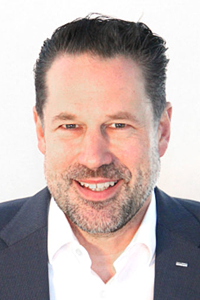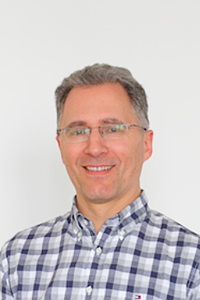
Name:
Prof. Max Christian Lemme
University & Institute:
RWTH Aachen University, Chair of Electronic Devices / AMO GmbH
Otto-Blumenthal-Str 25, 52074 Aachen
(www.eld.rwth-aachen.de / www.amo.de)
Biography:
Max C. Lemme (M’00–SM’06) received the Dipl.-Ing. and Dr.-Ing. degrees in electrical engineering from RWTH Aachen University, Aachen, Germany.
He is currently Professor of Electronic Devices at RWTH Aachen University and the Director of AMO GmbH, Aachen. Previously, he held positions as Professor at the University of Siegen, Guest Professor at KTH – Royal Institute of Technology, Sweden, Research Fellow at Harvard University, USA.
He received a NanoFutur award in Germany in 2006, an ERC Starting Grant in 2012 and an ERC proof-of-concept-grant in 2018. His current research interests include electronic, optoelectronic and nanoelectromechanical devices and sensors made from novel materials like graphene and related 2-D materials, Perovskites or phase change materials and their integration into the silicon technology platform.
Volunteer Position within EDS:
reviewer for JEDS, EDL and TED; guest editor JEDS
Email:
max.lemme@rwth-aachen.de / lemme@amo.de
Google Scholar:
https://scholar.google.com/citations?user=vX1EztkAAAAJ
Orcid:
https://orcid.org/0000-0003-4552-2411
Expertise:
Electronic devices, transistors, diodes, sensors, optoelectronics, photonics, semiconductor technology, silicon, graphene and 2D materials, perovskites for optoelectronics
Research Interests:
2D materials-based transistors and diodes, NEMS sensors, photodiodes, silicon and silicon nitride photonics
(Public) Research Labs:
Lithography
■ Raith EBPG 5200 e-beam system, 20/50/100 kV , sub 10 nm resolution, chips to 8“ wafers
■ Canon FPA 3000 i5r i-line Stepper with 0,5 μm resolution
■ EVG 420: 6” semi-automatic Maskaligner
■ EVG 150: 4”- 8” automatic resist coater and developer
■ Süss MA8 Gen3 SCIL: 2“-8“ UV-
Nanoimprint Lithography
■ EVG 770: 4“ – 8“ UV-Nanoimprint Step&Repeat Lithography
■ EVG 620 Soft UV Nanoimprint prototype: 4”- 6” lexible template size, sub 50 nm resolution
■ 2 experimental Interference Lithogarphy systems: 180 nm – 2.5 μm pitch, up to 8” substrates
Wet Processing
■ ARIAS Wet benches: single wafer and batch cleaning and resist processes
■ SCFluids Super Critical Dryer: CO2, semi-automatic, chips to 6” wafers
Furnaces
■ 3 Centrotherm Furnaces, chips to 8″ wafers, wet/dry Oxidation, POCl – Diffusion
■ Jipelec JetFirst, chips to 6” wafers, Rapid Thermal Annealing system CVD (Chemical Vapour Deposition)
■ 3 Centrotherm LPCVD furnaces, chips to 6″ wafers, Polysilicon, Silicon Nitride and LTO (low temp. SiO2)
Sputtering /Evaporators
■ Von Ardenne CS730 Cluster system: chips to 6”, DC and RF sputtering. Materials: W, Ni, Ti, TiN, Al, AlSi, AlCr, SiO2, Ta2O5, Al2O3, HfO2 , etc.
■ Pfeiffer Vacuum Classic 580: chips ti 6” wafers, e-beam and resistive evaporator, Materials: Al, Cr, Si02,Ti, Ta2O5 , etc.
Atomic Layer Deposition
■ 2 Oxford FlexAL Plasma assisted ALD, chips to 8“ wafers, Materials: AlN, Al2O3, TaN, TiN
Etchers
■ 3 Oxford PlasmaLab 100: RIE etchers, chips to 8“ wafers, chlorine, fluorine and bromine based chemistry
■ Tepla Semi 300: Microwave Plasma Etcher, batch and single wafer processes, 02 and CF4 processes
Metrology
■ Zeiss Supra 60 VP, EDX, High resolution SEM with automated CD control module
■ Brooker Dimension Scanning Probe Microscope, STM, AFM, MFM, chipsto 8” wafers
■ Veeco DekTak3ST surface profiler
■ Leica INM 100 and INM 300 optical microscopes
■ Philips PQ Ruby Ellipsometer
■ Horiba Raman spectrometer, chips to 8″ wafers
■ Witec Raman spectrometer, chips , including photoluminescence and scanning photocurrent measurements, vacuum capability
Test & Measurement
■ 2 Lakeshore probe stations, chips, 20-600 Kelvin, vacuum
■ Cascade probe station, chips to 8″ wafers, 300-500 Kelvin, nitrogen
■ Parameter analysers for small signal DC nanoelectronic device testing
■ LCR meters
■ Silicon Photonics device testing @1300 nm @1550 nm, tunable laser, iber & butt coupled
■ Bit rate error tester

Name:
Prof. Joachim Knoch
University & Institute:
RWTH Aachen University, Institute of Semiconductor Electronics
Biography:
Joachim Knoch studied physics at RWTH Aachen University and Queen Mary, University of London. He obtained the MSc and PhD degrees in physics from RWTH Aachen University in 1998 and 2001, respectively. From 2001 to 2002 he was a postdoctoral researcher at the Massachusetts Institute of Technology working on InP HEMTs.
Between 2003 and 2006 he was a research associate at Forschungszentrum Juelich, where where he investigated Schottky-barrier MOSFETs and Band-to-band Tunnel FETs. From 2006 to 2008 Joachim Knoch was a research staff member at IBM’s Zurich Research Laboratory working on nanowire field-effect transistors. In 2008 he was appointed associate professor at TU Dortmund University and continued to work on nanoscale field-effect transistor devices including 2D materials.
Since 2011 he has been full professor at RWTH Aachen University. His current research interest include the exploration of nanoelectronics devices for quantum information processing and neuromorphic systems based on different materials.
Volunteer Position within EDS:
Satellite, Expert in Nanoelectronics
Email:
knoch@iht.rwth-aachen.de
Orcid:
none
Expertise:
Nanoelectronics, Silicon Photovoltaics
Research Interests:
Low power nanoelectronics, cryogenic electronics, silicon fabrication technology for spin qubits, device based on 2D materials and carbon nanotubes
(Public) Research Labs:
Institute of Semiconductor Electronics is a founding member of Central Laboratory for Micro- and Nanoelectronics, the central clean-room facility at RWTH (http://cmnt.rwth-aachen.de/), Institute of Semiconductor Electronics is also part of the Forschungslabor Mikroelektronik Deutschland “2DForMe”
